Hyles lineata lineata
|
|
Updated as per
AN ANNOTATED CHECKLIST OF THE SPHINGIDAE OF BOLIVIA, October 2007
Updated as per http://biological-diversity.info/sphingidae.htm (Belize), November 2007
Updated as per Fauna Entomologica De Nicarauga, November 2007
Updated as per The Known Sphingidae of Costa Rica, November 2007
Updated as per personal communication with Patrick Demez: Puente Blanco, Ica, southwestern Peru, September 30, 2009
Updated as per personal communication with Jorge E. Frana (near San Guillermo City, Santa Fe, Argentina); December 2009
Updated as per personal communication with Eric LoPresti (Peru: Lambayeque: Pacora); December 11, 2012
Updated as per personal communication with Joanna Rodriguez Ramirez (Jujuy; San Luis; Argentina), January 21, 2015
Updated as per personal communication with April Villescas (Hyles lineata, wilmington, March 27, 2015); March 30, 2015
|
Hyles lineata lineata
HYE-leezmmlih-nee-AGH-tuh
(Fabricius, 1775) Sphinx
White-lined Sphinx
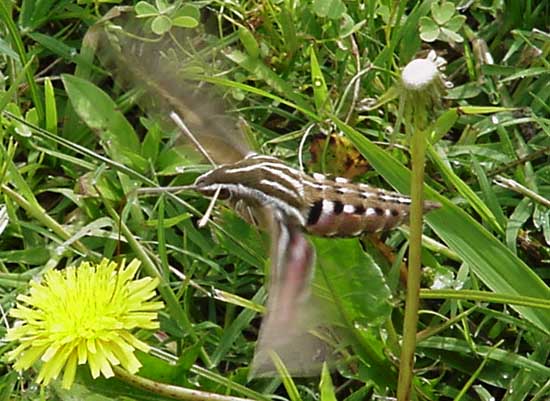
Hyles lineata nectaring in Arkansas in May, 2001
This site has been created by
Bill Oehlke at oehlkew@islandtelecom.com
Comments, suggestions and/or additional information are welcomed by Bill.
TAXONOMY:
Family: Sphingidae, Latreille, 1802
Subfamily: Macroglossinae, Harris, 1839
Tribe: Macroglossini, Harris, 1839
Genus: Hyles Hubner, [1819] ...........
Species: lineata lineata (Fabricius, 1775)
|
MIDI MUSIC
.....It's a Wonderful World.....
copyright C. Odenkirk
ON.OFF
<bgsound src="world.mid" LOOP=FOREVER>
|
DISTRIBUTION:
The White-lined Sphinx, Hyles lineata
lineata (Wing span: 2 7/16 - 3 9/16 inches (6.3 - 9 cm))
is widespread and common from Central America north through Mexico
and the West Indies to most of the
United States and southern Canada. A somewhat similar moth,
Hyles livornica
occurs in Eurasia and Africa.
In South America it has been observed in
Peru: Puente Blanco, Ica, southwestern Peru (PD); Lambayeque: Pacora (EL);
Bolivia:
Santa Cruz: road from Valle Grande to Padilla (2250m);
Argentina: Catamarca, Cordoba, La Rioja, Salta, Santa Fe (JEF), Tucuman; Jujuy and San Luis (JRR).
It has also been recorded in
Ecuador;
Colombia; and
Venezuela.
In Central America it has been reported in
Mexico;
Belize: Cayo;
Nicaragua: Madriz, Esteli, Boaco, Chinandega,
Leon, Managua, Masaya, Granada; and
Costa Rica: Guanacaste. It probably flies throughout Central America.
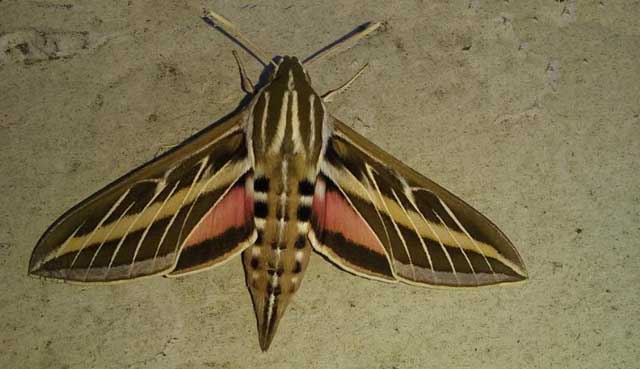
Hyles lineata, Wilmington, Los Angeles County, California,
March 27, 2015, courtesy of April Villescas.
The forewing upperside is dark olive brown with
paler brown along the costa and outer margin, a narrow tan band
running from the wing tip to the base, and white streaks along the
veins.
The hindwing upperside is black with a reddish pink median band.
Image courtesy of John Adams. |
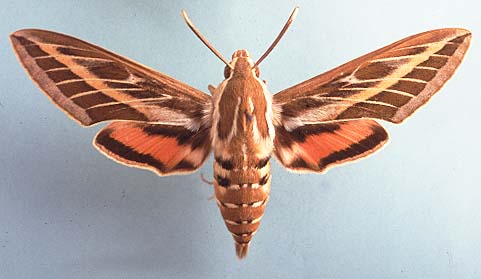 |
FLIGHT TIMES:
There are at least two broods
(probably multiple broods) annually
from February-November. Adults usually fly at dusk, during the night,
and at dawn, but they will also fly during the day over a wide
variety of open habitats including deserts, suburbs and gardens.
During the summer of 2001 I received many requests for garden
caterpillar identifications from the western and midwestern U.S.
Massive population buildups occur which stimulate emigrations to
colonize more northern areas, and I received emails from Minnesota
asking for identification. The image below comes from Altona, Manitoba, courtesy of
Liz Wieler, September 12, 2005.
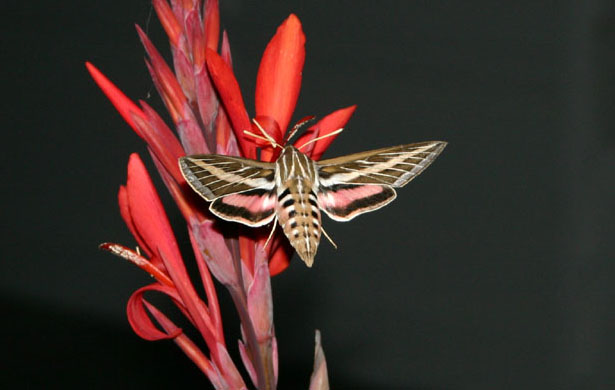 Liz writes, "I saw your website on the above moth, thanks to a friend
of mine.
Liz writes, "I saw your website on the above moth, thanks to a friend
of mine.
"I found it interesting. I had no idea what this was. I've seen
them here the last couple of years, and I caught this one last night
at dusk and after just a bit of rain.
"Do they overwinter here?"
I do not think this species overwinters in Canada as I have no
reports of spring or early summer sightings, except for
British Columbia where mild winters can be tolerated.
On August 20, 2008, Marshall Kuykendall, writes, "We live in Lordsburg, New Mexico, located in the southwest corner of the state. Two weeks ago there were thousands of
caterpillars crawling across the desert here. We have not seen this kind here before, and we have lived here several decades. They were about three or four inches long
and had a horn at the posterior end, similar to a "tomato worm". They had yellow stripes. They crawled from the north to the south, so thick a person could not walk
without stepping on one. Hundreds climbed up the blade of the tractor and up the wall of the barn.
"When they started to disappear, they were completely gone within two or three days. We don't know where they came from, where they were going, or
how they disappeared They did not seem to be eating anything, but just continued their crawling, all in the same direction. It is usually quite dry here, but we have
had two or three big rains during the last few weeks.
"I am a biology student, and would be interested in identifying the caterpillars, and I would also like to know their origin, and what happened to them. From what I know,
a caterpillar comes from an egg, laid by a moth or butterfly, and usually they are found on the type of plant the young worm eats before it continues its metamorphosis."
I replied, "There are frequent population explosions of this migratory sphingid. Each female is capable of laying hundreds of eggs, probably over 500 eggs from some females.
The mature caterpillars excavate subterranean chambers in which to pupate. So they may now be underground.
"Birds and rodents and lizards may have eaten a fair number. The larvae may have eaten all their foodplant and may have been on a march to try to find more.
"It is not unusual for me to receive reports similar to the one you have writtten."
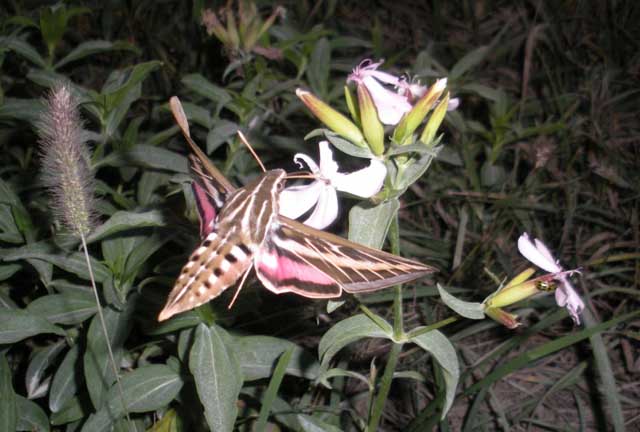
Hyles lineata, nectaring at bouncing bet,
Hitaga Sand Ridge Prairie Preserve, Linn County, Iowa,
October 8, 2011,
Tom Jantscher.
ECLOSION:
Pupae probably wiggle to surface from subterranean chambers just prior to eclosion.
Many thanks also to Erik Stahl who sends the following images and interesting note:
"I have had numerous sightings of large moths in my yard and while trying to identify them I eventually found my way to a website that listed your name as a good
contact.
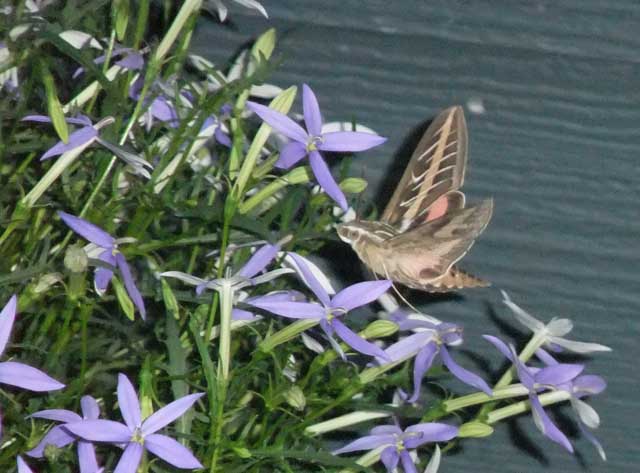
Hyles lineata, Saint Louis Park, Hennepin County, Minnesota,
May 28, 2012, courtesy of Erik Stahl.
"From the pictures at this site, I'm pretty sure that the moths visiting my yard are White-Lined Sphinx. I live in Saint Louis Park, Minnesota (Hennepin County),
and the website seems to indicate that these have been seen by others in my area. If you could confirm this from the attached photo, I'd be extremely
appreciative to have an expert confirmation.
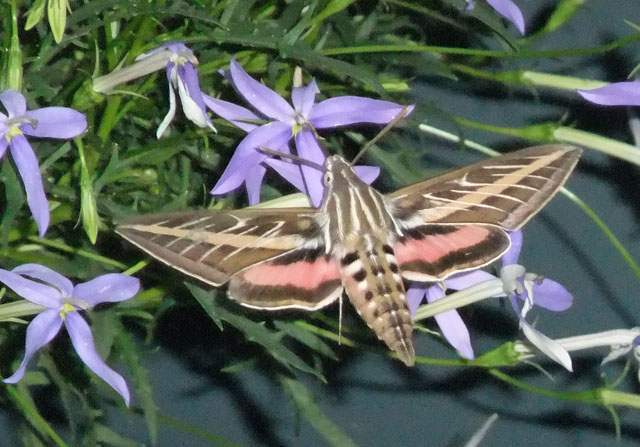
Hyles lineata, Saint Louis Park, Hennepin County, Minnesota,
May 28, 2012, courtesy of Erik Stahl.
"I'm also a gardener and one of my favorite plants/flowers is Laurentia. Only a small number of the garden stores here carry it so
it isn't the most common plant, but I always get wonderful compliments about it and many people who walk by my yard ask me what it is. It blooms all summer long
and at the end of the summer it doesn't look that much different from how it looks right now. What I've discovered is that Laurentia seems to be a major
attractant for these moths. During the day, I rarely see any bees, flies, butterflies, or other pollinators showing any interest in it at all. However, right at
dusk, I've been noticing that these moths come to visit the Laurentia. When I first put the Laurentia pots out this year a couple weeks ago, there
was one moth who would come visit every night. Tonight I had four of these moths visiting these pots at the same time. I watched (and took photos) as they went
from flower to flower, and all four of them were there for over twenty minutes before flying away.
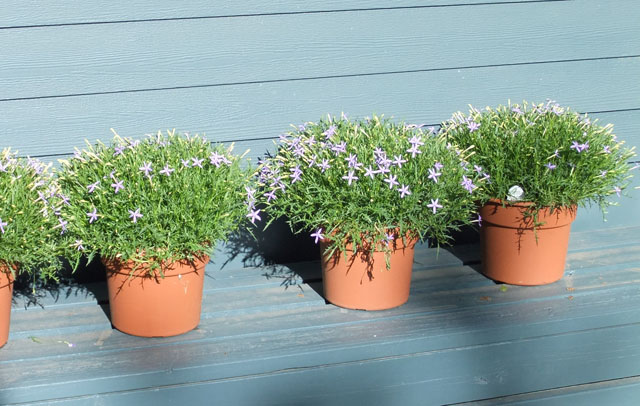
Laurentia pots, Saint Louis Park, Hennepin County, Minnesota,
courtesy of Erik Stahl.
"I thought I'd pass this story about the Laurentia along in case it might be of interest to anyone else who wants to attract these moths. The moths seem to
be stopping by every night at dusk now. Any help you can provide in confirming that my photo is the White-Lined Sphinx is also highly appreciated!
Thank you very much."
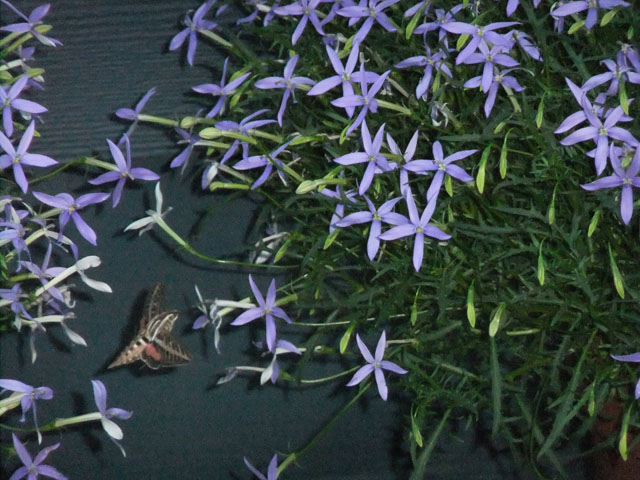
Laurentia and guest, Saint Louis Park, Hennepin County, Minnesota,
courtesy of Erik Stahl.
Again, many thanks to Erik for sharing photos. If you would like to see these moths in your yard, get some Laurentia!
SCENTING AND MATING:
Females call in the males with a pheromone released from a gland at the tip of the
abdomen.
On the wing in broad daylight, this species, with its striking colors, is a welcome
visitor to the home garden when they are not in such numbers as to have done damage to vegetation in the larval stage. Adults nectar from a variety of flowers
including columbines, larkspurs, petunia, honeysuckle, moonvine, bouncing bet, lilac, clovers, thistles, bergamot,
spotted jewelweed, hosta, Laurentia (ES) and
Jimpson weed.
Image courtesy of William Hark. | 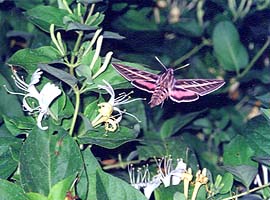 |
Michelle Swan reports Hyles lineata nectaring on Dianthus gratianopolitanus and Salvia greggii,
April 1, 2008 in Dallas/Fort Worth area of Texas.
EGGS, LARVAE AND PUPAE:
Larvae are highly varied and feed on a great diversity of plants including willow
weed (Epilobium), four o'clock (Mirabilis), apple (Malus), evening primrose (Oenothera), elm
(Ulmus), grape (Vitis), tomato (Lycopersicon),
purslane (Portulaca), and Fuschia.
When larvae are done feeding, they excavate shallow underground chambers in which to pupate. When the moths are ready to emerge, the pupae wiggle themselves
up to the surface so the emergent moth has an easy exit.
Joan F. Rickert from Medford, Taylor County, Wisconsin, has documented moths eclosing in as few as 21 days from pupation. Development time may be even shorter
in warmer areas. The fall brood pupae overwinter.
Visit Hyles lineata "underground" pupation chamber courtesy of Cristina J. Sheats.
Kathy Kloba from Austin, Texas, reports larva feeding on
Gaura lindheimerii mid April, 2006.
Deb Wilson reports a Hyles lineata larva feeding on Brazilian Wax Pepper in her garden in Rollingwood (west of Austin), Texas,
May 7, 2009. Deb also confirms Euphorbia dentata (toothed spurge), from the same area.
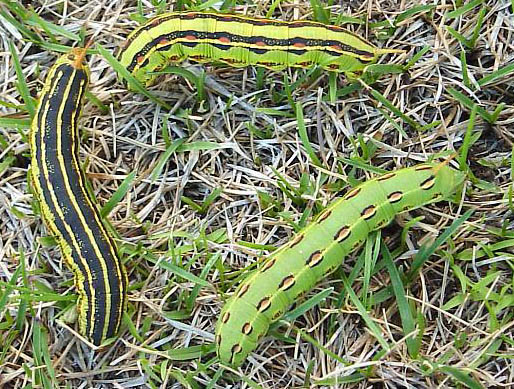
Photo courtesy of Scott Smith.
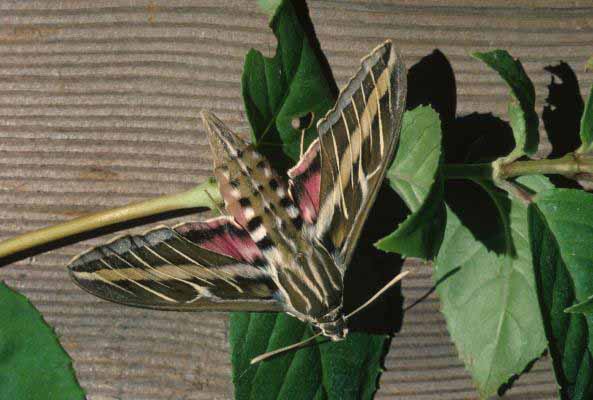
June 24, 1978, Hawthorne,
California © Donald H. Gudehus
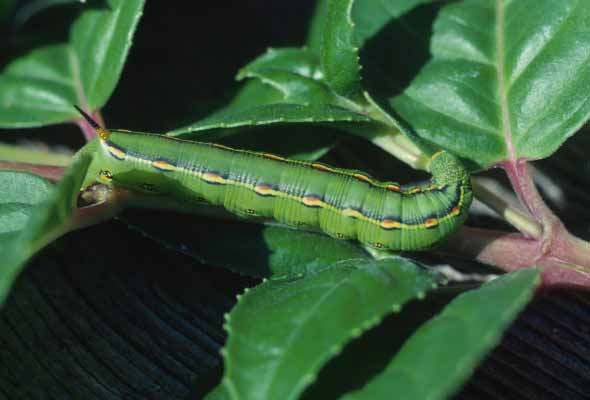
May 14, 1978, Hawthorne, California, © Donald H. Gudehus
Boerhaavia caribaea has been reported as a larval host on the
Galapagos Islands.
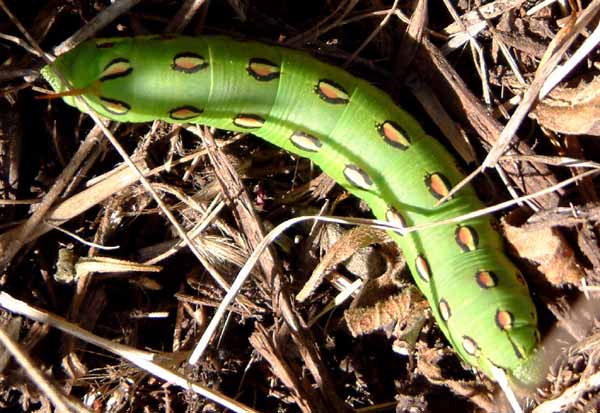
April 25, 2003, San Antonio, Texas,
courtesy of Ron Aaron.
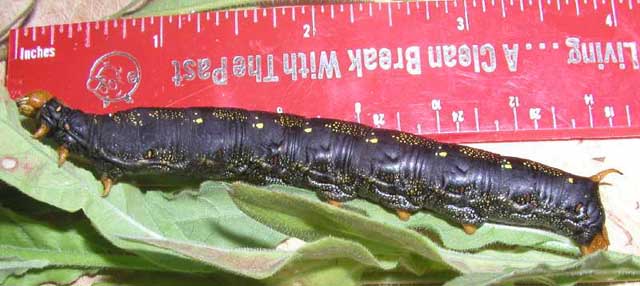
Very dark Hyles lineata, eating Guara, April 18, 2007,
courtesy of Carol, Eagle Pass area,
(on the TX-MX border WSW of San Antonio),
via Mike Quinn, id by Bill Oehlke.
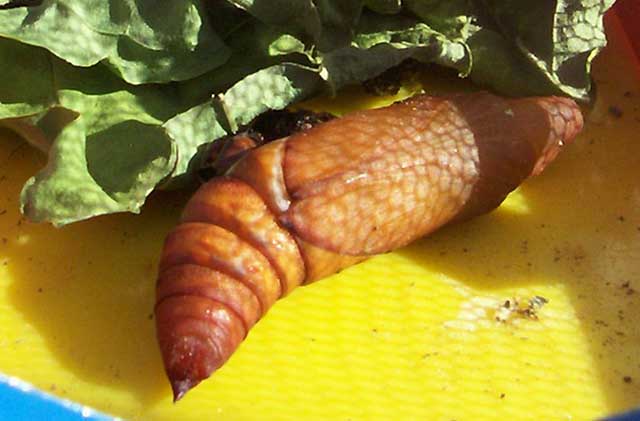
Hyles lineata pupa, Okanagan Region, British Columbia, Canada, courtesy of Paul Richman family
Paul Richman writes, "I found some useful information on a caterpillar I have been trying to identify at your site
http://www.silkmoths.bizland.com/hlinelin.htm. The caterpillar was found by my son Sebastian.
"The emergent moth confirms the ID.
"Sebastian found the larva between Lumby and Cherryville in the Okanagan region of British Columbia, also referred to as the Southern Interior."
Those who first published descriptions and
assigned scientific names to many insects, simply chose names of
biblical or mythological origin without any real descriptive
qualities. Their purpose was simply to set a standard for purposes
of identification by assigned name. On some occasions, names,
mostly of Latin or Greek origin, were chosen to signify a particular
character of the genus or of an individual species.
In Greek mythology, Hyles is one of the centaur warriors who fights
against the lapiths.
The species name, "lineata", is descriptive of the little lines
across the forewings.
The pronunciation of scientific names is
troublesome for many. The "suggestion" at the top of the page is
merely a suggestion. It is based on commonly
accepted English pronunciation of Greek names and/or some
fairly well accepted "rules" for latinized scientific names.
The suggested pronunciations, on this page and on other pages,
are primarily put forward to assist those who hear with internal
ears as they read.
There are many collectors from different countries whose
intonations and accents would be different.
Visit Hyles lineata pupa and emerged
moth courtesy of Karen Perizzolo.
Visit Hyles lineata larva, Arizona,
courtesy of David Bygott.
Visit Hyles lineata moth,
British Columbia, Canada,
courtesy of Marius Aurelian.
Visit Hyles lineata moth,
Zacatecas, Mexico, courtesy of Jean Haxaire.
Visit Hyles lineata
moth, Bradford County, Florida, courtesy of Edith Smith.
Vist Hyles lineata female, fifth instar
and pupa (three views) from Cordoba, Argentina, courtesy of Nigel Venters.
Visit Hyles lineata Puente Blanco, Ita, Peru, September 30, 2009, courtesy of Patrick Demez.
Visit Hyles lineata larvae, near San Guillermo City, Santa Fe, Argentina, courtesy of Agustin Sinde and Jorge E. Frana.
Visit Hyles lineata, Amancay, Cordoba, Argentina, February 2010, courtesy of Carlos Marzano.
Visit Hyles lineata, September 24, 2010, Chatham, Kent County, Ontario, Canada, courtesy of
John van der Pryt.
Visit Hyles lineata, July 23, 2012, Windsor, Ontario, Canada, courtesy of
Tammy Palmer.
Visit Hyles lineata, Shreveport, Caddo Parish, Louisiana, October 10, 2012, Jeff Trahan.
Visit Hyles lineata adult: May 31, 2007; larva July 10, 2009; Medford, Taylor County, Wisconsin, Joan F. Rickert
Visit Hyles lineata, nectaring at bouncing bet, Hitaga Sand Ridge Prairie Preserve, Linn County, Iowa, October 8, 2011,
Tom Jantscher;
nectaring at petunia, Noelridge Park, Cedar Rapids, Linn County, Iowa, October 9, 2011, Tom Jantscher.
Use your browser "Back" button to return to the previous page.
Goto Main Sphingidae Index
Goto Macroglossini Tribe
Goto Central American Indices
Goto Carribean Islands
Goto South American Indices
Goto U.S.A. tables
Use your browser "Back" button to return to the previous page.
This page is brought to you by
Bill Oehlke and the
WLSS. Pages are on space rented from Bizland. If you would like
to become a "Patron of the Sphingidae Site", contact Bill.
Please send sightings/images to Bill. I will do my best to respond to
requests for identification help.
Enjoy one of nature's wonderments: Live
Saturniidae (Giant Silkmoth) cocoons.
 | 
Show appreciation for this site by clicking on flashing butterfly to the left.
The link will take you to a page with links to many insect sites. |

















